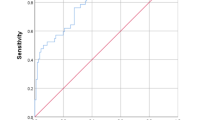Abstract
Objective
To identify the risk factors for pneumonia and severe pneumonia in children.
Design
Prospective cohort study.
Setting
Five tertiary-care teaching hospitals in India.
Participants
Children 2 to 59 months of age suffering from acute respiratory infection (ARI).
Main outcome measures
Risk factors for the development of WHO defined pneumonia and severe pneumonia.
Result
A total of 18159 children screened, and 7026 (39%) children with ARI were enrolled. According to the WHO criteria, 938 (13.4%) and 6088 (86.6%) of the enrolled children had pneumonia and no pneumonia, respectively. Out of 938 children with pneumonia, 347 (36.9%) had severe pneumonia. On univariate analysis, younger age, male gender and low weight for height, were significant risk factors for pneumonia. On multivariate analysis, one-unit increase in age in months (OR = 0.97; 95% CI: 0.97–0.98) and weight for height z-score (OR = 0.76; 95% CI: 0.72–0.79) had a protective effect.
Conclusions
Young age and undernutrition (low weight for height/length) in children are significant independent risk factors for pneumonia.
Similar content being viewed by others
References
Nair H, Simões EA, Rudan I, et al. Global and regional burden of hospital admissions for severe acute lower respiratory infections in young children in 2010: a systematic analysis. Lancet. 2013;381:1380–90.
Rudan I, Boschi-Pinto C, Biloglav Z, Mulholland K, Campbell H. Epidemiology and etiology of childhood pneumonia. Bull World Health Organ. 2008;86:408–16.
Bryce J, Boschi-Pinto C, Shibuya K, Black RE; WHO Child Health Epidemiology Reference Group. WHO estimates of the causes of death in children. Lancet. 2005; 365:1147–52.
Rudan I, O’Brien KL, Nair H, Liu L, Theodoratou E, Qazi S; Child Health Epidemiology Reference Group (CHERG). Epidemiology and etiology of childhood pneumonia in 2010: Estimates of incidence, severe morbidity, mortality, underlying risk factors and causative pathogens for 192 countries. J Glob Health. 2013;3:010401.
Teepe J, Grigoryan L, Verheij TJ. Determinants of community-acquired pneumonia in children and young adults in primary care. Eur Respir J. 2010;35:1113–17.
Farr BM, Woodhead MA, Macfarlane JT, et al. Risk factors for community-acquired pneumonia diagnosed upon hospital admission. Respir Med. 2000;94:954–63.
Falguera M, Carratalà J, Ruiz-Gonzalez A, et al. Risk factors and outcome of community-acquired pneumonia due to Gram negative bacilli. Respirology. 2009;14:105–11.
Song JH, Oh WS, Kang CI, et al. Clinical outcomes and risk factors of community-acquired pneumonia caused by Gram-negative bacilli. Eur J Clin Microb Infect Dis. 2008;27:657–61.
Lanata CF, Rudan I, Boschi-Pinto C, et al. Methodological and quality issues in epidemiological studies of acute lower respiratory infections in children in developing countries. Int J Epidemiol. 2004;33:1362–72.
World Health Organization. Acute respiratory infections in children: Case management in small hospitals in developing countries. A manual for doctors and other senior health workers. World Health Organization. 1990.
Pocket Book of Hospital Care for Children: Guidelines for the Management of Common Illnesses with Limited Resources. 2nd ed. World Health Organization, 2013.
Child Growth Standards. Accessed June 16, 2020. Available from https://www.who.int/childgrowth/software/en/
Kirkwood BR, Gove S, Rogers S, Lob-Levyt J, Arthur P, Campbell H. Potential interventions for the prevention of childhood pneumonia in developing countries: A syste-matic review. Bull World Health Organ. 1995;73:793–8.
Fonseca Lima EJ, Mello MJ, Albuquerque MF, et al. Risk factors for community-acquired pneumonia in children under five years of age in the post-pneumococcal conjugate vaccine in Brazil: A case control study. BMC Pediatr. 2016;6:157.
Wu PS, Chang IS, Tsai FY, et al. Epidemiology and impacts of children hospitalized with pneumonia from 1997–2004 in Taiwan. Pediatr Pulmonol. 2009;44:162–66
Bhuyan GS, Hossain MA, Sarker SK, et al. Bacterial and viral pathogen spectra of acute respiratory infections in under-5 children in hospital settings in Dhaka city. PLoS One. 2017;12:e0174488.
Muenchhoff M, Goulder PJ. Sex differences in pediatric infectious diseases. J Infect Dis. 2014;209:S120–6.
Ginsburg AS, Izadnegahdar R, Berkley JA, Walson JL, Rollins N, Klugman KP. Undernutrition and pneumonia mortality. Lancet Glob Health. 2015;3:e735–e36.
Rytter MJ, Kolte L, Briend A, Friis H, Christensen VB. The immune system in children with malnutrition—A systematic review. PLoS One. 2014;9:e105017.
Chisti MJ, Tebruegge M, La Vincente S, Graham SM, Duke T. Pneumonia in severely malnourished children in developing countries-mortality risk, etiology and validity of WHO clinical signs: A systematic review. Trop Med Int Health. 2009;14:1173–89.
Theodoratou E, Johnson S, Jhass A, et al. The effect of Haemophilus influenzae type b and pneumococcal conjugate vaccines on childhood pneumonia incidence, severe morbidity and mortality. Int J Epidemiol. 2010; 39:i172–i85.
Hortal M, Estevan M, Meny M, Iraola I, Laurani H. Impact of pneumococcal conjugate vaccines on the incidence of pneumonia in hospitalized children after five years of its introduction in Uruguay. PLoS One. 2014;9:e98567.
Gresh L, Kuan G, Sanchez N, et al. Burden of influenza and influenza-associated pneumonia in the first year of life in a prospective cohort study in Managua, Nicaragua. Pediatr Infect Dis J. 2016;35:152–6.
Acknowledgements
Gayatri, Jyotshnarani Sahoo, Manaswini Biswal, Prakash Wari, Saba, Umaisa Zehra, Vedasree, and Vikas Patwa for collecting data for the project.
Funding
Funding: This work was supported by Bill and Melinda Gates Foundation through The INCLEN Trust International (Grant number: OPP1084307). The funding source had no contribution in study design, implementation, collection and interpretation of data and report writing. Competing interest: None stated.
Author information
Authors and Affiliations
Contributions
JPG, PK: involved in data collection and manuscript writing; AM, RL: involved in development of protocol, supervision of study, data analysis; RRD, JIB, VR, BV: data collection, manuscript review and final approval of study.
Corresponding author
Ethics declarations
Permission number AIIMS/IEC/2017/301; date 15/09/2017.
Additional information
List of ATU group members provided as annexure I.
Rights and permissions
About this article
Cite this article
Goyal, J.P., Kumar, P., Mukherjee, A. et al. Risk Factors for the Development of Pneumonia and Severe Pneumonia in Children. Indian Pediatr 58, 1036–1039 (2021). https://doi.org/10.1007/s13312-021-2369-1
Received:
Revised:
Accepted:
Published:
Issue Date:
DOI: https://doi.org/10.1007/s13312-021-2369-1




